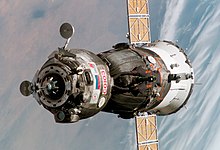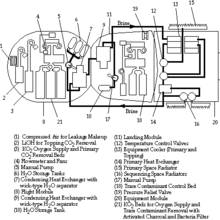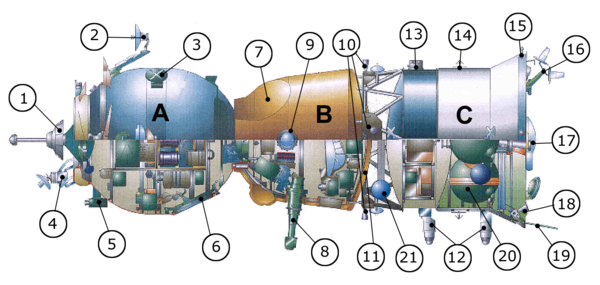From Wikipedia, the free encyclopedia
- For the launch vehicle of the same name see Soyuz (rocket family)

Soyuz spacecraft (TMA version)
|
|
| General information | |
|---|---|
| Manufacturer | Korolev |
| Country of origin | Soviet Union, Russia |
| Applications | Carry cosmonauts to orbit and back; originally intended for Soviet Moonshot |
| Orbit regimes | Low Earth orbit (circumlunar spaceflight during early program) |
| Operator | Soviet space program/Russian Federal Space Agency |
| Lifetime | Up to six months docked to station |
| Production | |
| Status | In service |
| First launch | Soyuz 1, 1967 |
This photo was taken by the crew of Expedition 29 on board the ISS. The Soyuz is shown off-centre in the photo, just days before astronauts Mike Fossum, Satoshi Furukawa, and Sergey Volkov board this vehicle to come back to Earth.
The Soyuz spacecraft is launched by the Soyuz rocket, the most frequently used and most reliable launch vehicle in the world to date.[1][2] The Soyuz rocket design is based on the Vostok launcher, which in turn was based on the 8K74 or R-7A Semyorka, a Soviet intercontinental ballistic missile. Soyuz spacecraft are launched from the Baikonur Cosmodrome in Kazakhstan.
The first unmanned Soyuz mission was launched November 28, 1966; the first Soyuz mission with a crew (Soyuz 1) was launched April 23, 1967, but the cosmonaut on board, Vladimir Komarov, died during the flight's crash-landing. Soyuz 2 was an unmanned mission, and Soyuz 3, launched on October 26, 1968, was the first successful Soyuz manned mission. The only other fatal mission, Soyuz 11, killed the crew of three also during re-entry due to premature cabin depressurization. Despite these early fatalities, Soyuz is presently widely considered the world's safest, most cost-effective human spaceflight system,[3] as demonstrated by its unparalleled length of operational history.
Soyuz spacecraft were used to carry cosmonauts to and from Salyut and later Mir Soviet space stations, and are now used for transport to and from the International Space Station (ISS). At least one Soyuz spacecraft is docked to ISS at all times for use as an escape craft in the event of an emergency.
The Soyuz spacecraft is intended to be replaced by the six-person Prospective Piloted Transport System.[4]
Contents
Design
A Soyuz spacecraft consists of three parts (from front to back):- A spheroid orbital module, which provides accommodation for the crew during their mission;
- A small aerodynamic reentry module, which returns the crew to Earth;
- A cylindrical service module with solar panels attached, which contains the instruments and engines.
Soyuz can carry up to three crew members and provide life support for about 30 person days. The life support system provides a nitrogen/oxygen atmosphere at sea level partial pressures. The atmosphere is regenerated through KO2 cylinders, which absorb most of the CO2 and water produced by the crew and regenerates the oxygen, and LiOH cylinders which absorb leftover CO2.
The vehicle is protected during launch by a nose fairing, which is jettisoned after passing through the atmosphere. It has an automatic docking system. The ship can be operated automatically, or by a pilot independently of ground control.
Orbital Module
The forepart of the spacecraft is the orbital module (Russian: бытовой отсек (БО); Bytovoi otsek (BO)), also known as Habitation section. It houses all the equipment that will not be needed for reentry, such as experiments, cameras or cargo. The module also contains a toilet, docking avionics and communications gear. Internal volume is 6 m³, living space 5 m³. On the latest Soyuz versions (since Soyuz TM), a small window was introduced, providing the crew with a forward view.A hatch between it and the descent module can be closed so as to isolate it to act as an airlock if needed, crew members exiting through its side port (near the descent module). On the launch pad, the crew enter the spacecraft through this port.
This separation also lets the orbital module be customized to the mission with less risk to the life-critical descent module. The convention of orientation in zero gravity differs from that of the descent module, as crew members stand or sit with their heads to the docking port.
Separation of the Orbital Module is critical for a safe landing. Without separation of the OM it is not possible for the crew to survive landing – that’s why the orbital module is separated before the ignition of the return engine. After the issue with the landing of Soyuz TM-5 in September 1988 this procedure was changed and the OM is separated after the return maneuver, which is more dangerous. Also the rescue of the crew whilst on the launch pad or with SAS system is complicated because of the orbital module.
Reentry Module
The reentry module (Russian: спускаемый аппарат (СА); Spuskaemyi apparat (SA)) is used for launch and the journey back to Earth. Half of the reentry module is covered by a heat-resistant covering to protect it during re-entry; this half faces the Earth during re-entry. It is slowed initially by the atmosphere, then by a braking parachute, followed by the main parachute which slows the craft for landing. At one meter above the ground, solid-fuel braking engines mounted behind the heat shield are fired to give a soft landing. One of the design requirements for the reentry module was for it to have the highest possible volumetric efficiency (internal volume divided by hull area). The best shape for this is a sphere, but such a shape can provide no lift, which results in a purely ballistic reentry. Ballistic reentries are hard on the occupants due to high deceleration and cannot be steered beyond their initial deorbit burn. That is why it was decided to go with the "headlight" shape that the Soyuz uses—a hemispherical forward area joined by a barely angled conical section (seven degrees) to a classic spherical section heat shield. This shape allows a small amount of lift to be generated due to the unequal weight distribution. The nickname was thought up at a time when nearly every headlight was circular. Small dimensions of the reentry module led to it having only two-man crews after the death of the Soyuz 11 crew. The later Soyuz T spacecraft solved this issue. Internal volume of Soyuz SA is 4 m³; 2.5 m³ is usable for crew (living space).Service Module
At the back of the vehicle is the service module (Russian: приборно-агрегатный отсек (ПАО); Priborno-Agregatnyi Otsek (PAO)). It has a pressurized container shaped like a bulging can (Instrumentation compartment, PO (Priborniy Otsek)) that contains systems for temperature control, electric power supply, long-range radio communications, radio telemetry, and instruments for orientation and control. A non-pressurized part of the service module (Propulsion compartment, AO (Agregatniy Otsek)) contains the main engine and a liquid-fuelled propulsion system for maneuvering in orbit and initiating the descent back to Earth. The ship also has a system of low-thrust engines for orientation, attached to the Intermediate compartment (PkhO or Perekhodnoi Otsek). Outside the service module are the sensors for the orientation system and the solar array, which is oriented towards the sun by rotating the ship. An incomplete separation between the Service and Reentry modules led to emergency situations during Soyuz 5, Soyuz TMA-10 and Soyuz TMA-11, which led to an incorrect reentry orientation (crew ingress hatch first). The failure of several explosive bolts did not cut the connection between the Service/Reentry modules on the latter two flights.Re-entry procedure
The Soyuz uses a method similar to the Apollo Command/Service modules to de-orbit itself. The spacecraft is turned engine-forward and the main engine is fired for de-orbiting fully 180° ahead of its planned landing site. This requires the least propellant for re-entry, the spacecraft traveling on an elliptical Hohmann orbit to a point where it will be low enough in the atmosphere to re-enter.Early Soyuz spacecraft would then have the service and orbital modules detach simultaneously from the reentry module. As they are connected by tubing and electrical cables to the reentry module, this would aid in their separation and avoid having the descent module alter its orientation. Later Soyuz spacecraft detached the orbital module before firing the main engine, which saved propellant. Since the Soyuz TM-5 landing issue, the orbital module is once again detached only after the re-enter firing, which led to (but did not cause) emergency situations of Soyuz TMA-10 and TMA-11. The orbital module cannot remain in orbit as an addition to a space station, as the airlock hatch between the orbital and reentry modules is a part of reentry module, and the orbital module therefore depressurizes after separation.
Re-entry firing is usually done on the "dawn" side of the earth, so that the spacecraft can be seen by recovery helicopters as it descends in the evening twilight, illuminated by the sun when it is above the shadow of the Earth. The Soyuz craft is designed to come down on land, usually somewhere in the deserts of Kazakhstan in central Asia. This is in contrast to early US manned missions which "splashed down" in the ocean.
Spacecraft systems
- Thermal Control System—Sistema Obespecheniya Teplovogo Rezhima, SOTR
- Life Support System—Kompleks Sredstv Obespecheniya Zhiznideyatelnosti, KSOZh
- Power Supply System—Sistema Elektropitaniya, SEP
- Communication and Tracking Systems—Rassvet (Dawn) radio communications system, Onboard Measurement System (SBI), Kvant-V spacecraft control, Klyost-M television system, Orbit Radio Tracking (RKO)
- Onboard Complex Control System—Sistema Upravleniya Bortovym Kompleksom, SUBK
- Combined Propulsion System—Kompleksnaya Dvigatelnaya Ustanovka, KDU
- Chaika-3 Motion Control System (SUD)
- Optical/Visual Devices (OVP)—VSK-4 (Vizir Spetsialniy Kosmicheskiy-4), Night Vision Device (VNUK-K, Visir Nochnogo Upravleniya po Kursu), Docking light, Pilot's Sight (VP-1, Vizir Pilota-1), Laser Range Finder (LPR-1, Lazerniy Dalnomer-1)
- Kurs rendezvous system
- Docking System—Sistema Stykovki i Vnutrennego Perekhoda, SSVP
- Teleoperator Control Mode—Teleoperatorniy Rezhim Upravleniya, TORU
- Entry Actuators System—Sistema Ispolnitelnikh Organov Spuska, SIO-S
- Landing Aids Kit—Kompleks Sredstv Prizemleniya, KSP
- Portable Survival Kit—Nosimiy Avariyniy Zapas, NAZ, containing a TP-82 or other pistol
- Soyuz Launch Escape System—Sistema Avariynogo Spaseniya, SAS
Variants
The Soyuz spacecraft has been the subject of continuous evolution since the early 1960s. Thus several different actual versions, proposals and projects exist.Soyuz 7K (part of the 7K-9K-11K circumlunar complex) (1963)
Main article: Soyuz A-B-V
Korolyov initially promoted the Soyuz A-B-V circumlunar complex (7K-9K-11K)
concept (also known as L1) in which a two-man craft Soyuz 7K would
rendezvous with other components (9K and 11K) in Earth orbit to assemble
a lunar excursion vehicle, the components being delivered by the proven
R-7 rocket.First generation
The manned Soyuz spacecraft can be classified into design generations. Soyuz 1 through Soyuz 11 (1967–1971) were first-generation vehicles, carrying a crew of up to three without spacesuits and distinguished from those following by their bent solar panels and their use of the Igla automatic docking navigation system, which required special radar antennas. This first generation encompassed the original Soyuz 7K-OK and the Soyuz 7K-OKS for docking with the Salyut 1 space station. The probe and drogue docking system permitted internal transfer of cosmonauts from the Soyuz to the station.The Soyuz 7K-L1 was designed to launch a crew from the Earth to circle the moon, and was the primary hope for a Soviet circumlunar flight. It had several test flights in the Zond program from 1967–1970 (Zond 4 to Zond 8), which produced multiple failures in the 7K-L1's re-entry systems. The remaining 7K-L1s were scrapped. The Soyuz 7K-L3 was designed and developed in parallel to the Soyuz 7K-L1, but was also scrapped. Soyuz 1 was plagued with technical issues, and cosmonaut Vladimir Komarov was killed when the spacecraft crashed during its return to Earth. This was the first in-flight fatality in the history of spaceflight.
The next manned version of the Soyuz was the Soyuz 7K-OKS. It was designed for space station flights and had a docking port that allowed internal transfer between spacecraft. The Soyuz 7K-OKS had two manned flights, both in 1971. Soyuz 11, the second flight, depressurized upon re-entry, killing its three-man crew.
Second generation
The second generation, called Soyuz Ferry or Soyuz 7K-T, comprised Soyuz 12 through Soyuz 40 (1973–1981).It was developed out of the military Soyuz concepts studied in previous years and was capable of carrying 2 cosmonauts with Sokol space suits (after the Soyuz 11 accident). Several models were planned, but none actually flew in space. These versions were named Soyuz P, Soyuz PPK, Soyuz R, Soyuz 7K-VI, and Soyuz OIS (Orbital Research Station).
The Soyuz 7K-T/A9 version was used for the flights to the military Almaz space station.
Soyuz 7K-TM was the spacecraft used in the Apollo-Soyuz Test Project in 1975, which saw the first and only docking of a Soyuz spacecraft with an Apollo spacecraft. It was also flown in 1976 for the earth-science mission, Soyuz 22. Soyuz 7K-TM served as a technological bridge to the third generation.
Third generation
The third generation Soyuz-T (T: транспортный, Transportnyi meaning transport) spacecraft (1976–1986) featured solar panels allowing longer missions, a revised Igla rendezvous system and new translation/attitude thruster system on the Service module. It could carry a crew of three, now wearing spacesuits.Fourth generation
Soyuz-TM (1986-2003)
Main article: Soyuz-TM
Soyuz-TMA (2003–2012)

The Soyuz TMA-6
Main article: Soyuz-TMA
Soyuz TMA-M (2010—present time)
Main article: Soyuz TMA-M
The Soyuz TMA-M is an upgrade of the baseline Soyuz-TMA, using a new
computer, digital interior displays, updated docking equipment and
vehicle's total mass has been reduced by 70 kilograms. This new version
debuted on 7 October 2010 with the launch of TMA-01M, carrying the ISS Expedition 25 crew.[6]The Soyuz TMA-08M set a new record for the fastest manned docking into space station, event utilized the new 6-hour fast rendezvous instead of the previous Soyuz launches which had, since 1986, taken two days.[7]
Soyuz MS (2017/...)
Soyuz MS is the final planned upgrade of Soyuz spacecraft. Its maiden flight is expected to happen in 2017.[8] Upgrade features major changes like:[9][10]- more power efficient solar panels
- modified docking and altitude control engines for increased fault tolerance during docking and de-orbit burns
- new approach and docking system
- improved communications system
- unified command/telemetry system allows to receive telemetry from spacecraft via satellite and control it when it's out of sight of ground stations
- employment of GLONASS/GPS and Cospas-Sarsat satellite systems during search/rescue operations of descent module after landing
Related craft
The unmanned Progress spacecraft were derived from Soyuz and are used for servicing space stations.While not being direct derivatives of Soyuz, the Chinese Shenzhou spacecraft and the Indian Orbital Vehicle follow the same general layout as that pioneered by Soyuz.
General Electric published their Apollo D-2 in December 1961 at the American Astronautical Society symposium in Denver, CO. This American design has many similarities to the early Russian spacecraft designs.
Operators
- Union of Soviet Socialist Republics: 1966-1991
- Russian Federation: 1992 to present
See also
- ISRO Orbital Vehicle
- Orbital Technologies Commercial Space Station
- Apollo D-2
- Spacecraft
- Sokol space suit
- Space exploration
- Space Shuttle orbiter - American equivalent from 1981 to 2011
- Human spaceflight
- Crew Space Transportation System study to develop a European-Russian successor to Soyuz
- Voskhod Spacecraft "Globus" IMP navigation instrument
- Zarya spacecraft project
- Shenzhou















No comments:
Post a Comment